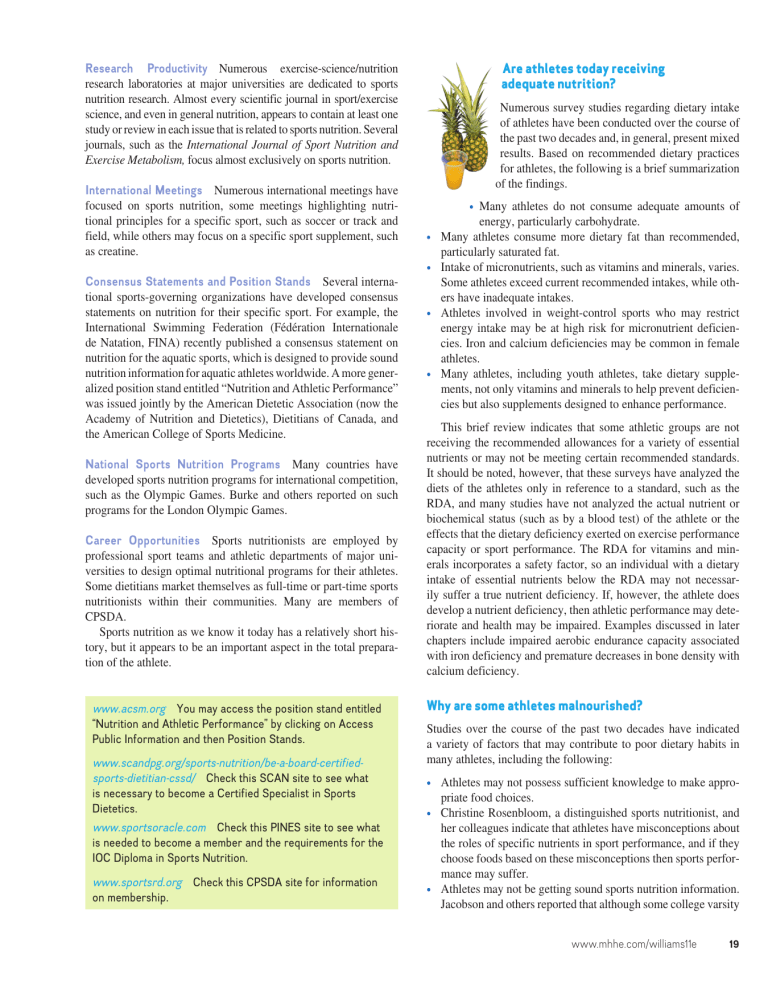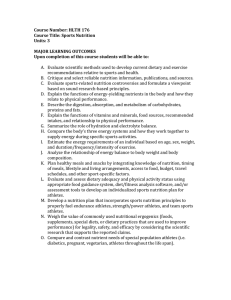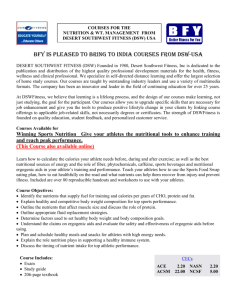
Are athletes today receiving adequate nutrition? Research Productivity Numerous exercise-science/nutrition research laboratories at major universities are dedicated to sports nutrition research. Almost every scientific journal in sport/exercise science, and even in general nutrition, appears to contain at least one study or review in each issue that is related to sports nutrition. Several journals, such as the International Journal of Sport Nutrition and Exercise Metabolism, focus almost exclusively on sports nutrition. International Meetings Numerous international meetings have focused on sports nutrition, some meetings highlighting nutritional principles for a specific sport, such as soccer or track and field, while others may focus on a specific sport supplement, such as creatine. Consensus Statements and Position Stands Several international sports-governing organizations have developed consensus statements on nutrition for their specific sport. For example, the International Swimming Federation (Fédération Internationale de Natation, FINA) recently published a consensus statement on nutrition for the aquatic sports, which is designed to provide sound nutrition information for aquatic athletes worldwide. A more generalized position stand entitled “Nutrition and Athletic Performance” was issued jointly by the American Dietetic Association (now the Academy of Nutrition and Dietetics), Dietitians of Canada, and the American College of Sports Medicine. National Sports Nutrition Programs Many countries have developed sports nutrition programs for international competition, such as the Olympic Games. Burke and others reported on such programs for the London Olympic Games. Career Opportunities Sports nutritionists are employed by professional sport teams and athletic departments of major universities to design optimal nutritional programs for their athletes. Some dietitians market themselves as full-time or part-time sports nutritionists within their communities. Many are members of CPSDA. Sports nutrition as we know it today has a relatively short history, but it appears to be an important aspect in the total preparation of the athlete. www.acsm.org You may access the position stand entitled “Nutrition and Athletic Performance” by clicking on Access Public Information and then Position Stands. www.scandpg.org/sports-nutrition/be-a-board-certifiedsports-dietitian-cssd/ Check this SCAN site to see what is necessary to become a Certified Specialist in Sports Dietetics. www.sportsoracle.com Check this PINES site to see what is needed to become a member and the requirements for the IOC Diploma in Sports Nutrition. www.sportsrd.org Check this CPSDA site for information on membership. Numerous survey studies regarding dietary intake of athletes have been conducted over the course of the past two decades and, in general, present mixed results. Based on recommended dietary practices for athletes, the following is a brief summarization of the findings. ∙ ∙ ∙ ∙ ∙ Many athletes do not consume adequate amounts of energy, particularly carbohydrate. Many athletes consume more dietary fat than recommended, particularly saturated fat. Intake of micronutrients, such as vitamins and minerals, varies. Some athletes exceed current recommended intakes, while others have inadequate intakes. Athletes involved in weight-control sports who may restrict energy intake may be at high risk for micronutrient deficiencies. Iron and calcium deficiencies may be common in female athletes. Many athletes, including youth athletes, take dietary supplements, not only vitamins and minerals to help prevent deficiencies but also supplements designed to enhance performance. This brief review indicates that some athletic groups are not receiving the recommended allowances for a variety of essential nutrients or may not be meeting certain recommended standards. It should be noted, however, that these surveys have analyzed the diets of the athletes only in reference to a standard, such as the RDA, and many studies have not analyzed the actual nutrient or biochemical status (such as by a blood test) of the athlete or the effects that the dietary deficiency exerted on exercise performance capacity or sport performance. The RDA for vitamins and minerals incorporates a safety factor, so an individual with a dietary intake of essential nutrients below the RDA may not necessarily suffer a true nutrient deficiency. If, however, the athlete does develop a nutrient deficiency, then athletic performance may deteriorate and health may be impaired. Examples discussed in later chapters include impaired aerobic endurance capacity associated with iron deficiency and premature decreases in bone density with calcium deficiency. Why are some athletes malnourished? Studies over the course of the past two decades have indicated a variety of factors that may contribute to poor dietary habits in many athletes, including the following: ∙ Athletes may not possess sufficient knowledge to make appropriate food choices. ∙ Christine Rosenbloom, a distinguished sports nutritionist, and her colleagues indicate that athletes have misconceptions about the roles of specific nutrients in sport performance, and if they choose foods based on these misconceptions then sports performance may suffer. ∙ Athletes may not be getting sound sports nutrition information. Jacobson and others reported that although some college varsity www.mhhe.com/williams11e 19 athletes received nutrition information from reliable sources, such as dietitians and athletic trainers, considerable nutrition information was obtained from less reliable sources such as magazines and coaches with an inadequate education in sports nutrition. ∙ Finances and time may limit preparation of healthier meals, particularly with college athletes. Healthy meal preparation may take a back seat to time needed for sport practice and class and study time. However, the future looks bright. SCAN and the CPSDA have partnered with the NCAA Sports Science Institute to publish nutrition information monthly on its Website. Along with increased emphasis on sports nutrition education for collegiate strength and conditioning coaches, such endeavors may help improve nutrition among collegiate athletes. Various education programs also are being developed for professional and youth sports by various groups, such as, respectively, the National Football League and the President’s Council on Fitness, Sports, & Nutrition. Such programs should help. For example, Valliant and others reported a nutrition education program was useful in improving dietary intake and nutrition knowledge of female athletes. How does nutrition affect athletic performance? Provide energy for various energy systems Improve acid-base balance and reduce acidity Enhance mental functions Increase bone mineral density and strength Increase oxygen transport and delivery Prevent muscle tissue damage Regulate body temperature Increase muscle tissue growth Enhance energyproducing metabolic pathways Facilitate recovery following exercise Increase mechanical efficiency F I G U R E 1 . 9 Nutrients in the foods we eat and dietary strategies may The nutrients in the foods we eat influence exercise or sport performance in a variety of ways. They may can affect exercise and sports provide energy for the various human energy systems, may help regulate performance in accordance various metabolic processes important to exercise, and may promote the with the three major functions growth and development of various body tissues and organs important for energy production during exercise. of nutri­ ents. First, nutrients may provide energy for the differ­ent energy-producing What should athletes eat to help systems dis­cussed in chapter 3. Second, nutrients also help regoptimize sport performance? ulate metabolic processes important to energy production and temperature regulation during exercise. Third, nutrients support Melinda Manore, an expert in sports the growth and development of specific body tissues and organs nutrition, noted that there is no doubt as they adapt to exercise training; figure 1.9 highlights some of that the type, amount, composition, the roles diet and nutrients play during exercise. A well-planned and timing of food intake can dramatically affect exercise perforsport-specific diet will help optimize sports performance, but a mance, recovery from exercise, body weight and composition, and poor diet plan may lead to impaired performance. health. The importance of nutrition to your athletic performance Malnutrition represents unbalanced nutrition and may exist may depend on a variety of factors, including your gender, your as either undernutrition or overnutrition, that is, an individual age, your body weight status, your eating and lifestyle patterns, does not receive an adequate intake (undernutrition) or consumes the environment, the type of training you do, and the type of sport excessive amounts of single or multiple nutrients (overnutrition). or event in which you participate. As an example of the last point, Either condition can hamper athletic performance. An inadequate the carbohydrate needs of a golfer or baseball player may vary intake of certain nutrients may impair athletic performance due little from those of the nonathlete, whereas those of a marathon to an insufficient energy supply, an inability to regulate exercise runner or ultraendurance triathlete may be altered significantly metabolism at an optimal level, or a decreased synthesis of key during training and competition. body tissues or enzymes. In contrast, excessive intake of some The opinions offered by researchers in the area of exercise and nutrients may also impair athletic performance, and even the nutrition relative to optimal nutrition for the athlete run the gamut. health of the athlete, by disrupting normal physiological processes At one end, certain investigators note that the daily food requireor leading to undesirable changes in body composition. ment of athletes is quite similar to the nutritionally balanced diet 20 C H A P T E R 1 Introduction to Nutrition for Health, Fitness, and Sports Performance for everyone else, and therefore no special recommendations are needed. At the other extreme, some, such as sports supplement companies, state that it is almost impossible to obtain all the nutrients the athlete requires from the normal daily intake of food, and for that reason nutrient supplementation is absolutely necessary. Other reviewers advocate a compromise between these two extremes, recognizing the importance of a nutritionally balanced diet but also stressing the importance of increased consumption of specific nutrients or dietary supplements for athletes in certain situations. The review of the scientific literature presented in this book supports the latter point of view. In general, athletes who consume enough Calories to meet their energy needs and who meet the requirements for essential nutrients should be obtaining adequate nutrition. The dietary guidelines for better health, as discussed previously and expanded upon in chapter 2, are the same for optimal physical performance. The key to sound nutrition for the athletic individual is to eat a wide variety of healthful foods. Although a healthy diet is the foundation of a dietary plan for athletes, modifications may be important for training and competition in various sports. For example, adequate carbohydrate is important as an energy source for aerobic endurance athletes, adequate protein may help optimize muscle development in strength/ power athletes, and adequate iron may help ensure adequate oxygen delivery in female athletes. Some basic guidelines regarding eating for training and for competition are presented in chapter 2, whereas details regarding the use of specific nutrients, such as carbohydrate and protein, are presented in the chapter highlighting that nutrient. Some athletes believe that there are super foods or diets that provide a competitive advantage in sports. Numerous sports supplements are marketed to athletes with this premise in mind and have been the subject of considerable research by sports nutrition scientists. The following section discusses the general role of such supplements in the enhancement of sports performance, while more details on specific sports supplements are presented in the chapter highlighting that nutrient. Chapter 13 also details the role of herbals and other sports supplements. Key C o n c e p t s c Success in sports is primarily dependent on genetic endow- ment and proper training, but nutrition can also be an important contributing factor. c The major objectives of sports nutrition are to promote good health and adaptations to training, to recover quickly after each training session, and to perform optimally during competition. c Studies reveal that although athletes desire to eat a diet that may enhance sports performance, their knowledge of nutrition is often inadequate, and some are not meeting the dietary recommendations of sports nutritionists. c In general, the diet that is optimal for health is optimal for sports performance. However, athletes involved in certain sports may benefit from specific dietary modifications. Ergogenic Aids and Sports Performance: Beyond Training Since time immemorial, athletes have attempted to use a wide variety of techniques or substances to enhance sports performance beyond the effects that could be obtained through training. In sport and exercise science terminology, such techniques or substances are referred to as ergogenic aids. What is an ergogenic aid? As mentioned previously, the two key factors important to athletic success are genetic endowment and state of training. At certain levels of competition, the contestants generally have similar genetic athletic abilities and have been exposed to similar training methods, and thus they are fairly evenly matched. Given the emphasis placed on winning, many athletes training for competition are always searching for the ultimate method or ingredient to provide that extra winning edge. Indeed, some suggest that two of the key factors leading to better athletic records in recent years are improved diet and ergogenic aids. The word ergogenic is derived from the Greek words ergo (meaning work) and gen (meaning production of) and is usually defined as to increase potential for work output. In sports, various ergogenic aids, or ergogenics, have been used for their theoretical ability to improve sports performance by enhancing physical power, mental strength, or mechanical edge. There are several different classifications of ergogenic aids, grouped according to the general nature of their application to sport. The first two classifications below are often referred to as performance-enhancing techniques, whereas the last three classifications involve taking some substance into the body and are known as performanceenhancing substances. We have listed several major categories with an example of one theoretical ergogenic aid for each. Mechanical Aids Mechanical, or biomechanical, aids are designed to increase energy efficiency, to provide a mechanical edge. Lightweight racing shoes may be used by a runner in place of heavier ones so that less energy is needed to move the legs and the economy of running increases. Psychological Aids Psychological aids are designed to enhance psychological processes during sport performance, to increase mental strength. Hypnosis, through posthypnotic suggestion, may help remove psychological barriers that limit physiological performance capacity. Physiological Aids Physiological aids are designed to augment natural physiological processes to increase physical power. Blood doping, or the infusion of blood into an athlete, may increase oxygen transport capacity and thus increase aerobic endurance. However, its use is illegal. Pharmacological Aids Pharmacological aids are drugs designed to influence physiological or psychological processes to increase physical power, mental strength, or mechanical edge. Anabolic steroids, whose use is prohibited in sports, are still used by some athletes to help increase muscle mass, strength, and power. www.mhhe.com/williams11e 21


